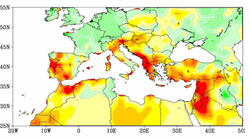Several recent studies demonstrate the relationship between increasing violence and extreme weather, including the demise of civilizations after prolonged drought.
It seems the war in Syria started after four years of drought that forced people to flee to cities, while farmers suffered without any help from government.
By Joe Romm, first published on Climate Progress.
Warming-worsened drought is causing problems all around the Mediterranean, especially Syria:

NOAA concluded in 2011 that "human-caused climate change [is now] a major factor in more frequent Mediterranean droughts." Reds and oranges highlight lands around the Mediterranean that experienced significantly drier winters during 1971-2010 than the comparison period of 1902-2010.
With our country facing tough choices about Syria, Moyers & Company’s John Light had a great piece on Friday: "Drought Helped Spark Syria’s Civil War – Is it One of Many Climate Wars to Come?" He interviewed one of our favorites, Francesco Femia, co-founder of the Center for Climate and Security, which has an advisory board of retired military commanders and foreign-policy experts.
Back in March 2012, Climate Progress ran a piece co-authored by Femia, in which he explained, "Syria’s current social unrest is, in the most direct sense, a reaction to a brutal and out-of-touch regime and a response to the political wave of change that began in Tunisia early last year. However, that’s not the whole story."
It’s now increasingly clear that the climate models that had been predicting the countries surrounding the Mediterranean would start to dry out were correct (see "NOAA: Human-Caused Climate Change Already a Major Factor in More Frequent Mediterranean Droughts" the source of the figure at the top).
In his interview with Light, Femia explains the role of drought in the conflict:
From 2006 to 2011, 60 percent of Syria’s land experienced, in the words of one expert, the worst long-term drought and most severe set of crop failures since agricultural civilizations began in the Fertile Crescent many millennia ago. That, on top of natural resource mismanagement by the Assad regime – subsidizing water-intensive wheat and cotton farming and unsustainable irrigation techniques – led to a large amount of devastation.
There are some quite frightening numbers. Herders and farmers in the north and south had to pick up and move. Nearly 75 percent of farmers in the northeast suffered total crop failure. Herders in the northeast lost around 85 percent of their livestock, which affected about 1.3 million people. That was happening before the civil war in Syria broke out.
Many international security analysts were saying, right up to the day before protest broke out in the small rural town of Daraa, that Syria was immune to the Arab Spring and to the grievances that other Arab publics had brought to bear on their leaders. And that clearly wasn’t the case.
There was quite a bit of displacement happening; millions were trekking into urban areas. Those urban areas were experiencing quite a bit of economic insecurity. Some of that was also coming from poverty and competition from other influxes of people – for example, Iraqi refugees who had been flowing into Syria since 2003, and also Palestinian refugees. These were cities that were already hard-pressed economically…. Under the surface of what seemed to be a stable country, there was a large-scale environmental and human disaster happening.
Earlier this year, New York Times columnist Tom Friedman explained in his piece "Without Water, Revolution":
This Syrian disaster is like a superstorm. It’s what happens when an extreme weather event, the worst drought in Syria’s modern history, combines with a fast-growing population and a repressive and corrupt regime and unleashes extreme sectarian and religious passions, fueled by money from rival outside powers….
"The drought did not cause Syria’s civil war," said the Syrian economist Samir Aita, but, he added, the failure of the government to respond to the drought played a huge role in fueling the uprising.
The fact that the 2011 NOAA analysis confirmed the climate models’ predictions of drying is especially worrisome because the climate models project a very dry future for large parts of the planet’s currently habited and arable land in the coming decades – particularly this region:
The 2010 NCAR study found "By the end of the century, many populated areas, including parts of the United States and much of the Mediterranean and Africa, could face readings in the range of -4 to -10. Such decadal averages would be almost unprecedented."
The NOAA study should be especially sobering to those in the Mediterranean since they clearly face some of the most extreme drying in the entire world:
The Mediterranean has long been identified as a "hot spot" for substantial impact from climate change in the latter decades of this century because of water scarcity in the region, a rapidly increasing population, and climate modeling that projects increased risk of drought.
"The question has been whether this projected drying has already begun to occur in winter, the most important season for water resources," [lead author Martin] Hoerling said. "The answer is yes."
In Femia’s interview, he notes, "a recent model of climate impact for the future conducted by The International Food Policy Research Institute projected that if current rates of greenhouse gas emissions continue, yields of rain-fed crops in Syria will likely decline between 29 and 57 percent from 2010 to 2050. That’s a huge number."
Femia concludes bluntly that the time to act is now:
… if you let this problem get out of hand you’re going to have a number of situations in the future, whether they’re major disasters or conflicts, that our security forces may have to respond to. It will cost us a lot more in the long term if we do nothing now.
Here is the full interview:
